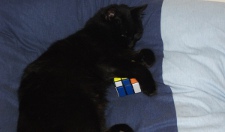Twisting Puzzles
Big Cubes - Cage Method
Introduction
The method described in the solution to the Rubik's Revenge scales up to work on a regular cube of any size. Minor variations of the algorithms will be enough to extend the approach to the larger puzzles. The 5, 6 and 7 methods are described here. The variations in the method are merely different ways of executing the same few algorithms to get a small change in the effect. All 3 cubes are shown here so that you can see how the algorithms change from one puzzle to the next and use the method as required on the bigger puzzles as they become available or you play online or software versions - which cost you nothing.
The cage method involves solving the outer pieces and then working inwards a layer at a time.
There are more centres than edges on the larger cubes, so this has to be a slower approach than the reduction method. It does, however, avoid parity problems and it requires only a small number of algorithms.
Notation
Notation for the face turns is as it is for the 3x3x3 cube. Slice turns are represented with lower case letters.
Professor's Cube
Slices have a lower case version of the letter that matches the face they are next to. The letter M refers to the vertical middle slice of the front face (between l and r) and turns towards you. The letter E refers to the horizontal slice of the front face (between u and d) and turns to the right. The letter S refers to the horizontal middle slice of the top face (between f and b) and turns like the F face.
V-Cube 6
This is the notation used in Jaap's method for this cube and it makes sense as the cubes get larger. Slices are identified by their subscript. For example, U2 means the slice immediately below and parallel to the U face and U3 would be the slice below that. The notation works the same for all faces.
V-Cube 7
Slices are identified by their subscript. For example, u2 means the slice immediately below and parallel to the U face and u3 would be the slice below that. The letter M refers to the vertical middle slice of the front face (between L3 and R3) and turns towards you. The letter E refers to the horizontal slice of the front face (between U3 and D3) and turns to the right. The letter S refers to the horizontal middle slice of the top face (between F3 and B3) and turns like the F face.
First Steps
There are some parts to this method that don't change enough to warrant explanation. The following stages need to be completed,
- Solve The Top Face
- Orient The Bottom Corners
- Permute The Bottom Corners
- Solve Top Layer Edges
- Solve Bottom Layer Edges
- Fill The Gaps
Solving Edges
The algorithm from the Rubik's Revenge for swapping edges can be used on any of the inner slices parallel to the U layer.
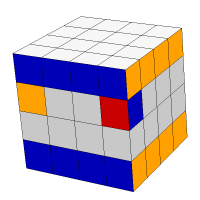
R' u' R' F2 R u R' F2 R2 u
Replace u with U2 or U3 to swap pieces on these two layers. For the lower layers, do the same algorithm but make all of the Dx turns go in the opposite direction to that indicated.
In the larger cubes, not all edges can mix with all positions. This means we have to adjust our edge swapping algorithms as follows,
Professor's Cube
The middle layer edges can be solved last. They don't mix with the other layers.
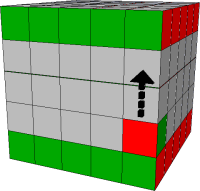
R2 d' R2 d' R2 d2 R2
V-Cube 6
On the V-Cube 6, the edges from the U2 and D2 layers can be swapped. Edges in the U3 and D3 layers can be swapped.
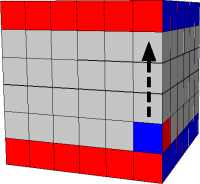
R2 D2' R2 D2' R2 D22 R2
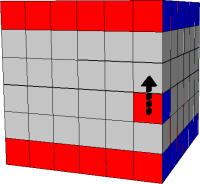
R2 D3' R2 D3' R2 D32 R2
V-Cube 7
On the V-Cube 7, the edges from the U2 and D2 layers can be swapped. Edges in the U3 and D3 layers can be swapped. The middle layer edges can be solved last by themselves - they don't mix with the edges in the other layers.
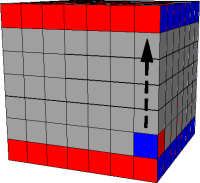
R2 D2' R2 D2' R2 D22 R2
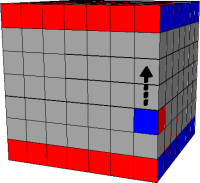
R2 D3' R2 D3' R2 D32 R2
Solving Centres
On the Rubik's Revenge, we only need one algorithm for this stage, swapping two centres at a time. On the larger cubes, the centres are not all interchangeable and some modifications to the algorithm are required.
Professor's Cube
If you think of the centres as a 3x3 face, the corners can all be solved using this algorithm with U and F setup moves.
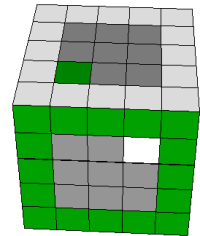
b' u' b U b' u b U'
The edges of the 3x3 face can be solved with this algorithm and U and F set-up moves.
The very centre of each face works like the 3x3x3 cube - no need to deal with that until all of the other centres are placed.
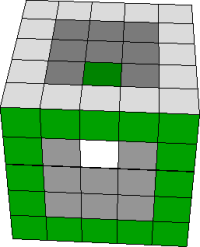
S u' S U S u S U'
V-Cube 6
The centres of a V-Cube 6 make up a 4x4 grid. The corners of that grid can be solved using the following algorithm,
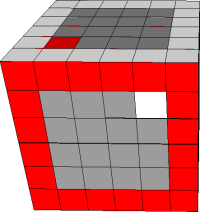
B2' U2' B2 U B2' U2 B2 U'
The next two algorithms will fill in the other outer pieces.
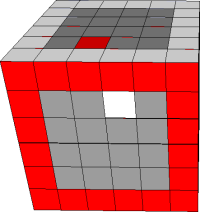
B3' U2' B3 U B3' U2 B3 U'
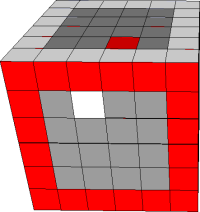
F3 U2' F3' U F3 U2 F3' U'
The 2x2 centre square can be solved using only the following algorithm and the usual set-up moves.
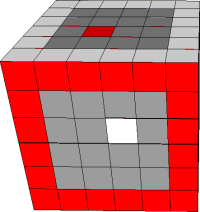
B2' U3' B2 U B2' U3 B2 U'
V-Cube 7
There are 25 centres on each face of the V7. It is slow going doing them one swap at a time like this. It does work though. The first algorithm targets the edges in the corner of that 5x5 square.

B2' U2' B2 U B2' U2 B2 U'
The centres to the left and right of these can be solved with the following two variants of the algorithm.
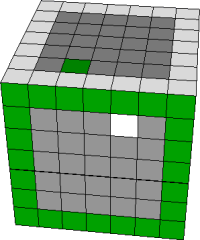
B3' U2' B3 U B3' U2 B3 U'
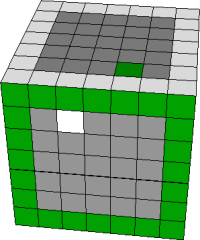
F3 U2' F3' U F3 U2 F3' U'
The last outer centres can be solved with the following algorithm.
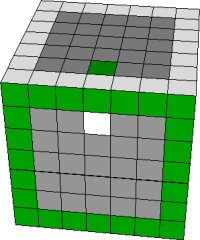
S U2' S U S U2 S U'
At this point, we need to target the inner 3x3 square of centres that are left. This is the approach we took on the V-Cube 5. The inner corners are solved with the following algorithm.
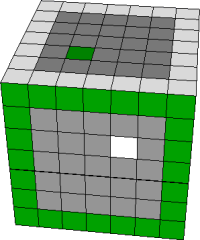
B3' U3' B3 U B3' U3 B3 U'
Then the centre of the inner 3x3 can be solved.
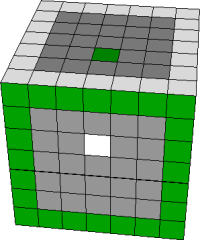
S U3' S U S U3 S U'
The pieces at the very centre of the cube can be placed quite easily as you might on a 3x3x3 cube.
Improving Upon This
The slowest part of this is the last part. You can speed this up with algorithms to swap more than one centre at a time. With a few set-up moves, it would be useful to be able to bring a centre from the R face into play. People have already found many of the algorithms you would need and, with a little experimentation on a solved cube, you can find some of your own.

